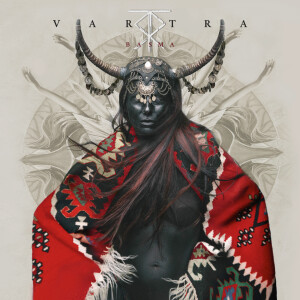 Coincidentally, earlier in the day that I sat down to compose this review of Vartra’s Basma, I listened to “Nos Veremos” from Y La Bamba’s Ojos del Sol, one of my favorite songs and albums of the past decade. Then as I re-listened to the dramatic music on Basma I thought about what makes that kind of music so compelling. The addition of deep, insistent, syncopated beats from forcefully struck frame drums takes the already dramatic women’s polyphonic harmony and boosts it to the stratosphere. And that very thing lies at the core of this album.
Coincidentally, earlier in the day that I sat down to compose this review of Vartra’s Basma, I listened to “Nos Veremos” from Y La Bamba’s Ojos del Sol, one of my favorite songs and albums of the past decade. Then as I re-listened to the dramatic music on Basma I thought about what makes that kind of music so compelling. The addition of deep, insistent, syncopated beats from forcefully struck frame drums takes the already dramatic women’s polyphonic harmony and boosts it to the stratosphere. And that very thing lies at the core of this album.
Basma is the second album by the Serbian folk collective called Vartra. The band makes music that’s fairly characterized as neo-Slavic doom folk, a tribal, rhythmic, shamanic blend of drone and beat, heightened by electronics, rattling percussion, didgeridoo and vocals that veer from soft chants to eerie wails. It’s easily the most dramatic music I’ve heard in many a season.
Vartra was founded in 2017 by musician and singer Siniša Gavrić (who plays guitar and many other instruments, and also sings) and sisters Ivana and Aleksandra Stošić, who both contribute lyrics and vocals, and Aleksandra plays saz. The collective includes four additional musicians, two acrobatic dancers and a graphic designer who does costumes, makeup, stage design and more.
I’m just going to quote from their website‘s description of Vartra:
Vartra is a collective of musicians, dancers and craftsmen based in Belgrade, Serbia, gathered around a common goal of bringing magic and mystery to the stage through a unique blend of their skills, interests and experiences. Our music is influenced by various genres, from traditional Balkan music characterized by the merging of Slavic and oriental cultures, through a variety of traditional music styles of indigenous cultures across the world, to a more harsh, industrial and dark atmospheric sound, common for genres such as doom metal. Most of our lyrics stem from old folk incantations and mantras from the Balkan area, that are sung in Serbian and Vlach languages. Our performances are enriched by utilizing handmade drums and rattles crafted by main instrumentalist and vocalist Siniša Gavrić. These instruments are made from animal skins and foraged materials from the rivers and mountains of Serbia.
So what’s the music like? If you’re a fan of Balkan style polyphony, or the music of Värttinä, you’ll find a lot to like here unless you’re a purist. Although considering the churning history and cultural milieu of the Balkans, it’s hard to imagine what cultural or artistic “purity” would look like there. Add to those vocals a foundation of deep tribal drumming, a bunch of shakers and rattles, some fiddle and guitar, and varying amounts of atmospheric electronics, all presented with a kind of wild shamanic spirit, and you have the music on Basma. (The saz, by the way, is a long-necked lute also called bağlama, used in Balkan music as well as Turkish, Kurdish, Armenian, Syrian and Iraqi. It has such a warm and vibrant sound, rather like an oud but with more of a tenor timbre from that long neck. Those dramatic drums I think are played by sound engineer Julius Velker; the physicist and mathematician Andrej Bunjac also plays drums and percussion.)
Personally, I’d be very happy to listen for hours to Ivana and Aleksandra Stošić sing those close harmonies with accompaniment from Aleksandra’s saz and those almost taiko-like drums, with some fiddle breaks from classically trained Ana Katić. That’s close to what you get in the album’s focal point, a three-track stretch titled “Sena,” “Trioka,” and “Vikriya.” All three feature lots of saz and violin instrumentals, plus some lovely polyphony from Ivana and Aleksandra. The last of the three “Varta-Vikriya” features some lead vocals from Gavrić that veer into doom metal territory.
All of the music is highly dynamic, a song often starting with instrumentals or quietly chanted vocal lines before crashing into a percussion-laden electro-shamanic dance. “Jerovine,” the second track, begins with a solo sevda type vocal, to which are added layers of electronic drones and drums and percussion; it features some three part harmonies from Ivana, Aleksandra, and Siniša toward the end, which are just lovely. “Inanna” begins with a slow circular chant enhanced by sounds of Jew’s harp and fiddle, but it eventually leaps into double tempo and gallops through a darkly mystical landscape. The opening and closing tracks are both quite dramatic.
From the breathy, guttural, gasping at the start of the opening track “Aina” (a lengthy episodic song with circular chant-singing, violin, electronica, and a wild howling as of wolves), to the way the last track “Ravno Polje” wraps things up with multi-part backing harmonies behind the darkly emotive vocals of Siniša, (with of course lots of drumming and droning and a spine-tingling denoument of the women’s polyphonic wails), Basma somehow doesn’t wear out its welcome but only gets more engrossing.
And yes, Basma is hard to describe without a lot of superlatives and repetition. There aren’t a lot of reference points for this kind of music and performance in American and Western European spaces. Best thing is to just check it out.
(CPL-Music, 2022)
